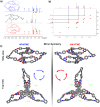Self-similar chiral organic molecular cages
- PMID: 38253630
- PMCID: PMC10803742
- DOI: 10.1038/s41467-024-44922-y
Self-similar chiral organic molecular cages
Abstract
The endeavor to enhance utility of organic molecular cages involves the evolution of them into higher-level chiral superstructures with self-similar, presenting a meaningful yet challenging. In this work, 2D tri-bladed propeller-shaped triphenylbenzene serves as building blocks to synthesize a racemic 3D tri-bladed propeller-shaped helical molecular cage. This cage, in turn, acts as a building block for a pair of higher-level 3D tri-bladed chiral helical molecular cages, featuring multilayer sandwich structures and displaying elegant characteristics with self-similarity in discrete superstructures at different levels. The evolutionary procession of higher-level cages reveals intramolecular self-shielding effects and exclusive chiral narcissistic self-sorting behaviors. Enantiomers higher-level cages can be interconverted by introducing an excess of corresponding chiral cyclohexanediamine. In the solid state, higher-level cages self-assemble into supramolecular architectures of L-helical or D-helical nanofibers, achieving the scale transformation of chiral characteristics from chiral atoms to microscopic and then to mesoscopic levels.
© 2024. The Author(s).
Conflict of interest statement
The authors declare no competing interests.
Figures






References
-
- Hasell, T. & Cooper, A. I. Porous organic cages: soluble, modular and molecular pores. Nat. Rev. Mater. 1, 16053 (2016).
Grants and funding
LinkOut - more resources
Full Text Sources

